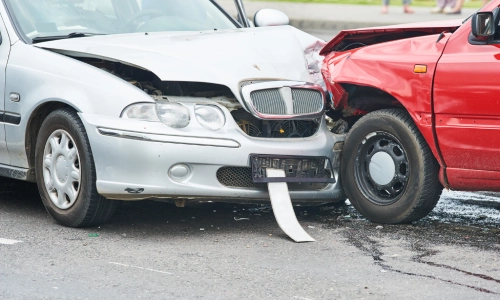Book a Consultation
Find out why so many clients appreciate the amount of work we put into their case.
"*" indicates required fields
Call 24/7
A sideswipe car accident happens when two vehicles traveling parallel to each other make contact, typically scraping along their sides. These accidents often result from driver errors during lane changes, merging, or distractions.
Understanding the causes and consequences of a sideswipe accident in Utah can help you navigate its legal and physical aftermath.

These incidents are common on multi-lane roads, highways, or during merging.
A side-impact crash, such as a sideswipe, is distinct from other types of crashes due to its glancing nature. Unlike T-bone or frontal collisions, which involve direct impacts, sideswipes often result in less severe structural damage but can still cause significant injuries or trigger chain-reaction crashes.
Their unique mechanics make determining fault more complex, as both drivers may share responsibility.
Sideswipe accidents typically cause scratches, dents, or paint transfers along the sides of vehicles. Damage may affect doors, fenders, side mirrors, or wheels.
While often cosmetic, severe sideswipes can misalign frames or damage internal components, leading to costly repairs.
Sideswipe collisions stem from a variety of driver errors or road conditions, as evidenced by the Utah Department of Public Safety’s crash statistics. Identifying the cause is critical for determining liability and preventing future incidents.
One of the most common causes of sideswipe crashes is a lane change collision due to improper lane changes. Drivers who fail to check their blind spots or signal their intentions may collide with vehicles in adjacent lanes.
Blind spot accidents are particularly prevalent with larger vehicles, such as trucks or SUVs.
Failure to maintain lane due to distractions, such as texting or adjusting the radio, can lead to a sideswipe. Similarly, aggressive driving behaviors, such as tailgating or weaving through traffic, increase the risk of side-impact collisions.
A merge lane accident often occurs when merging onto highways or changing lanes without yielding to oncoming traffic. Drivers who misjudge gaps or fail to yield to right-of-way rules may collide with vehicles already in the flow of traffic.
The risks associated with a sideswipe car accident depend on several factors, including vehicle speed, the size and weight difference between the vehicles involved, road conditions, and the driver’s response. While many sideswipe incidents result in minor damage, such as scratches or dents, the potential for serious consequences remains, particularly in specific scenarios.
These collisions can affect not only drivers and passengers but also pedestrians, cyclists, or nearby property if vehicles veer off the road. Understanding the specific risks associated with sideswipe accidents highlights the importance of defensive driving to prevent sideswipes, including maintaining proper lane discipline and situational awareness.
Passengers on the struck side of the vehicle are particularly vulnerable to sideswipe crash injuries due to their proximity to the impact zone, and the risks are amplified for motorcyclists or pedestrians who lack the protective structure of a vehicle. Prompt medical evaluation is critical, as some injuries may not be immediately apparent but can worsen without treatment.
Common injuries include:
The likelihood and severity of these injuries are influenced by vehicle design, including side-impact protection, as well as the use of safety features. Older vehicles with weaker structural integrity may exacerbate risks, underscoring the importance of modern safety standards.
One of the most dangerous aspects of sideswipe accidents is their potential to trigger multi-vehicle chain reactions, escalating a single incident into a complex and hazardous event. When one vehicle sideswipes another, it may cause the struck vehicle to swerve, leading to loss of control or veering into adjacent lanes, where it may collide with other cars, trucks, or even roadside barriers.
This domino effect is widespread in high-traffic areas, such as highways or urban intersections, where vehicles are closely spaced and drivers have limited time to react.
Chain-reaction crashes significantly increase the likelihood of severe injuries and fatalities due to the cumulative impact forces and the involvement of multiple vehicles. For instance, a sideswipe that pushes a car into oncoming traffic could result in a head-on collision, one of the deadliest types of crashes.
Determining fault in a sideswipe accident in Utah requires careful analysis of the circumstances and the state’s traffic laws.
Under Utah traffic laws, Utah follows a “fault” system, meaning the at-fault driver’s insurance typically covers damages. However, Utah also uses comparative negligence, allowing compensation even if you’re partially at fault, as long as your responsibility is less than 50%.
Your recovery is reduced by the percentage of fault attributed to you.
To determine who is at fault in a sideswipe accident, evidence like police reports, witness statements, dashcam footage, or traffic camera recordings is crucial. Demonstrating that the other driver failed to signal, check blind spots, or yield can establish their negligence.
An experienced attorney can help gather and present this evidence in an effective manner.
Taking the proper steps after a sideswipe collision can protect your health, safety, and legal rights.
Avoid admitting fault or discussing the accident in detail at the scene. Seek medical care promptly, even for minor injuries, to document your condition.
Notify your insurance company and ask about insurance coverage for sideswipe accidents, but consult an attorney before giving recorded statements to avoid jeopardizing your claim.
Navigating the aftermath of a sideswipe collision can be overwhelming, but you don’t have to face it alone. As experienced Salt Lake City car accident lawyers, Valley Law Accident & Injury Lawyers is here to guide you through the legal process..
Our experienced attorneys will investigate your accident, gather evidence, and negotiate with insurance companies to secure fair compensation for medical bills, lost wages, and pain and suffering. We understand Utah’s fault laws and will fight to protect your rights.
Don’t let a sideswipe accident derail your life; schedule a free consultation today. Contact Valley Law Accident & Injury Lawyers when you need a sideswipe crash attorney in Salt Lake City.
Call us at (801) 810-9999 to schedule your appointment today. Let us help you get the justice and compensation you deserve.
Get in touch


2021 and 2022 Gold Winner for Top Law Firm by Salt City Best
Call 24/7 801-810-9999